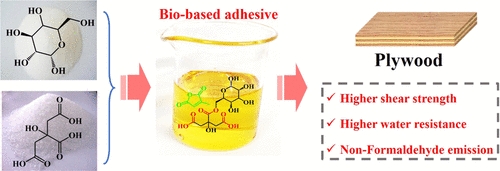博文
中法化学家开发了一种由葡萄糖和柠檬酸制成无毒胶合板胶
||
中法化学家开发了一种由葡萄糖和柠檬酸制成无毒胶合板胶
诸平


Fig. 2 Citric acid and glucose produce a wood glue that creates strong, water-resistant three-layer plywood. Credit: Adapted from ACS Applied Materials & Interfaces 2022, DOI: 10.1021/acsami.2c02859
美国化学学会(American Chemical Society)2022年5月11日提供的消息,化学家开发了一种由葡萄糖和柠檬酸制成无毒胶合板胶(Chemists Develop a Non-Toxic Glue for Plywood – From Glucose and Citric Acid)。
众所周知,胶合板和其他复合木制品广泛用于房屋建筑、家具和装饰。它们通常使用含有潜在致癌化学物质如甲醛的胶水和树脂来制作。用于建造家庭家具、装修装饰以及地板的材料,都是大板的复合木制品。但是粘合刨花板(particleboard)、纤维板(fiberboard)和胶合板(plywood)的胶水和树脂通常含有甲醛,可能会将这种致癌物质释放到空气中。为了开发一种无毒的粘合剂,中法研究人员合作于2022年5月11日在《美国化学会应用材料与界面》(ACS Applied Materials & Interfaces)杂志网站发表论文报道,他们将葡萄糖和柠檬酸(糖和一种橙汁成分)组合成一种用于胶合板的坚固、防水的木胶。详见Chunyin Li, Hong Lei, Zhigang Wu, Xuedong Xi, Guanben Du, Antonio Pizzi. Fully biobased adhesive from glucose and citric acid for plywood with high performance. ACS Applied Materials & Interfaces, Publication Date(Web): 11 May 2022. DOI: 10.1021/acsami.2c02859. https://pubs.acs.org/doi/10.1021/acsami.2c02859
参与此项研究的有来自中国昆明的西南林业大学(Southwest Forestry University)、中国贵阳的贵州大学(Guizhou University)以及法国洛林大学(University of Lorraine, Epinal, France)的研究人员。
为了制造胶合板,制造商将薄层的木材粘合在一起,然后在压力和热量下固化材料,创造出大型的、灵活的面板。在这种应用中使用的最流行的粘合剂之一是脲醛树脂(urea-formaldehyde resin),因为它价格低廉,牢固地粘在木材上。然而,这种类型的树脂胶合板的甲醛排放已经引起了健康和环境方面的关注。先前的研究表明,蔗糖(sucrose)是一种由葡萄糖(glucose)和果糖(fructose)组成的双单位糖。它和柠檬酸(citric acid)的溶液可以形成一种天然的防水木胶。然而,需要一种氯化锌催化剂来降低胶合板固化的能耗,这也降低了粘合剂的强度。因此,雷洪(Hong Lei音译)和她的同事们想看看纯葡萄糖和柠檬酸是否能在低能耗的固化过程中制造出一种强大的粘合剂。
研究人员将葡萄糖溶液和不同数量的柠檬酸加热成一种粘性液体,并将其涂在杨木单板上。然后,他们将三层贴面堆叠起来,在200 ℃下压成一片,持续6分钟。该团队将板材切割成更小的块进行强度测试,发现在大于101 psi的压力下,胶合板样品都沿着木材纤维断裂,而不是在胶合接缝处断裂。
这些结果满足中国胶合板的标准要求。当胶合板样品在热水或沸水中浸泡时,只有柠檬酸/葡萄糖比例大于0.6的胶合板样品的粘结强度满足标准要求。研究人员将这些结果归因于柠檬酸和木材之间酯连接的增加,这增加了木材的结合强度和耐水性。
研究人员说,柠檬酸-葡萄糖胶粘剂为木制品行业带来了希望。
该研究得到了中国国家自然科学基金(National Natural Science Foundation of China)、云南省自然科学基金(Yunnan Provincial Natural Science Foundation)、111项目(111 project)以及法国国家研究局(French National Research Agency)的资助。
上述介绍,仅供参考。欲了解更多信息,敬请注意浏览原文或者相关报道。

Biomass-based adhesives have attracted much attention due to their eco-friendly, sustainable characteristics compared to formaldehyde-based adhesives; however, their low bonding strength and water resistance restrict their application. Thus, developing a high-performance biomass-based adhesive with excellent bonding strength and water resistance is necessary. In this work, a fully biomass-based citric acid-glucose (CAG) adhesive was produced by the esterification reaction of glucose and citric acid, which was validated by Fourier transform infrared (FT-IR), 13C nuclear magnetic resonance (13C NMR), and liquid chromatography–mass spectrometry (LC–MS). Furthermore, the properties of the CAG adhesive were tuned considering the effects of reaction time and molar ratio of citric acid/glucose (CA/G). It was revealed that increasing the molar ratio of CA/G is more advantageous to improve the shear strength and water resistance of plywood than the reaction time. The dry and wet strengths of plywood bonded by the CAG adhesive can reach the standard requirement (≥0.7 MPa) when the molar ratios of CA/G were more than 0.6 and the reaction time was 1 h. These results were better than those bonded by the urea-formaldehyde (UF) resin. Therefore, this green adhesive shows great potential to replace the existing industrial UF resin adhesives.
https://blog.sciencenet.cn/blog-212210-1338546.html
上一篇:行星科学家为费米悖论提出了一个解决方案:超线性尺度导致奇点
下一篇:一个粒子在两条路径上:量子物理学是正确的
